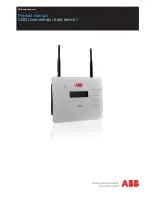
Global Water
800-876-1172
•
globalw.com
- 21 -
Logarithmic Timing:
Typically used in groundwater pump studies, this mode
speeds up the sample rate over time. Click the “Logarithmic” option to select this
mode. This a logarithmic approximation that steps up the sample rate:
a.
10 times per second for 20 seconds, 200 samples
b.
1 second interval for 100 seconds, 100 samples
c.
10 second interval for 10 minutes, 60 samples
d.
1 minute interval for 60 minutes, 60 samples
e.
10 minute interval for 10 hours, 60 samples
f.
1 hour interval for 48 hours, 48 samples
g.
1 day interval until memory s full
Log Upon Deviation:
Clicking the “Log only if Channel 1 change e/-“ box
causes the logger to record the current reading in memory only if it exceeds the
previously reading by the preset amount entered in the numeric field. This logging
exception applies to channel 1 only and the deviation is measured in Raw Data units
where the approximate raw data range is from 0-65535, corresponding to 0-20mA.
To find the actual number of raw data units per engineering unit, use the calibration
numbers in the Analog Setup screen for channel 1 as follows: Raw Data Units per
Engineering Unit = (High Raw – Low Raw) / (High EU – Low EU). For example:
Assume a 15 foot water level sensor has a High EU of 15, a Low EU of zero, a High
Raw of 62256 and a Low Raw of 13104. (62256-13104) / (15-0) = 3277 units/foot.
Thus, if you want to log only when a reading exceeds the previous on by 0.5 feet, set
the deviation to about 1638. Click the numeric field to enter the desired range.
Wrap records:
If the “Wrap records
at End of Storage” box is checked,
once the memory is full, the oldest data points will be replaced with the newest.
Thus, the memory block represents only the newest. If this feature is not checked,
the logger will halt recording once the memory is full.
Sample-On-Demand:
When this box is checked, applying a pulse to the Sample-
On-Demand input will cause the logger to take a data reading and store it in
memory. This feature works in all sampling modes and will not interrupt normal data
recording. If the sample interval is one hour, the historical record will show data










































